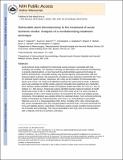| dc.contributor.author | Walcott, Brian | |
| dc.contributor.author | Boehm, Kevin M. | |
| dc.contributor.author | Stapleton, Christopher James | |
| dc.contributor.author | Mehta, Brijesh P. | |
| dc.contributor.author | Nahed, Brian Vala | |
| dc.contributor.author | Ogilvy, Christopher S. | |
| dc.date.accessioned | 2018-05-18T20:44:39Z | |
| dc.date.issued | 2013 | |
| dc.identifier.citation | Walcott, Brian P., Kevin M. Boehm, Christopher J. Stapleton, Brijesh P. Mehta, Brian V. Nahed, and Christopher S. Ogilvy. 2013. “Retrievable Stent Thrombectomy in the Treatment of Acute Ischemic Stroke: Analysis of a Revolutionizing Treatment Technique.” Journal of Clinical Neuroscience 20 (10) (October): 1346–1349. doi:10.1016/j.jocn.2013.03.015. | en_US |
| dc.identifier.issn | 0967-5868 | en_US |
| dc.identifier.uri | http://nrs.harvard.edu/urn-3:HUL.InstRepos:37034628 | |
| dc.description.abstract | Acute ischemic stroke resulting from intracranial vessel occlusion is associated with high morbidity and mortality. The mainstays of therapy are fibrinolytics and mechanical thrombectomy in properly selected patients. A new Food and Drug Administration-approved technology to perform thrombectomy, retrievable stenting, may provide superior revascularization rates and improved patient outcomes. We analyzed the cumulative human experience reported for the Trevo Pro Retrieval System (Stryker, Kalamazoo, MI, USA) and the Solitaire FR Revascularization Device (ev3, Irvine, CA, USA) as the definitive treatment for acute ischemic stroke. A literature search was undertaken to identify studies using the retrievable stents published up to September 2012. Nineteen studies identified a total of 576 patients treated with either the Trevo (n = 221) or Solitaire (n = 355) devices. Pooled data analysis identified baseline National Institutes of Health Stroke Scale scores of 18.5 ± 0.289 (standard error of the mean) and 17.9 ± 0.610, and time to recanalization of 53.9 ± 23.6 minutes and 59.0 ± 8.0 minutes for the Trevo and Solitaire groups, respectively. Recanalization was variably defined by individual studies, most commonly achieving at least a thrombolysis in cerebral infarction score of 2a–3 or a thrombolysis in myocardial infarction score of 2–3. Revascularization (83%, 82%), mortality (31%, 14%), hemorrhage (8%, 6%), device complications (5%, 6%), and good patient outcomes (51%, 47%) were found with the Trevo and Solitaire devices, respectively. Preliminary analysis reveals excellent clinical outcomes for retrievable stent technology. This may be attributable to both high rates of revascularization with a relatively short time to perfusion restoration. | en_US |
| dc.language.iso | en_US | en_US |
| dc.publisher | Elsevier BV | en_US |
| dc.relation.isversionof | doi:10.1016/j.jocn.2013.03.015 | en_US |
| dc.relation.hasversion | https://www.ncbi.nlm.nih.gov/pmc/articles/PMC3795895/ | en_US |
| dash.license | LAA | |
| dc.subject | endovascular | en_US |
| dc.subject | ischemia | en_US |
| dc.subject | neurosurgery | en_US |
| dc.subject | solitaire | en_US |
| dc.subject | stent | en_US |
| dc.subject | stroke | en_US |
| dc.subject | trevo | en_US |
| dc.title | Retrievable stent thrombectomy in the treatment of acute ischemic stroke: Analysis of a revolutionizing treatment technique | en_US |
| dc.type | Journal Article | en_US |
| dc.description.version | Accepted Manuscript | en_US |
| dc.relation.journal | Journal of Clinical Neuroscience | en_US |
| dash.depositing.author | Nahed, Brian Vala | |
| dc.date.available | 2018-05-18T20:44:39Z | |
| dc.identifier.doi | 10.1016/j.jocn.2013.03.015 | * |
| dash.contributor.affiliated | Ogilvy, Christopher | |
| dash.contributor.affiliated | Stapleton, Christopher | |
| dash.contributor.affiliated | Walcott, Brian | |
| dash.contributor.affiliated | Nahed, Brian | |


